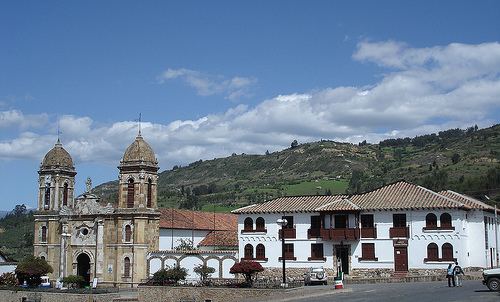Founded 19 December 1778 Website Official website Area 94.3 km² Local time Friday 11:50 AM | Founded by Manuel Antonio Flores Elevation 2,538 m Population 14,063 (2015) | |
 | ||
Time zone Colombia Standard Time (UTC-5) Weather 18°C, Wind E at 13 km/h, 56% Humidity | ||
Tibasosa colombia
Tibasosa ([tiβaˈsosa]) is a town and municipality in the Sugamuxi Province, part of the Colombian department of Boyacá. Tibasosa borders Duitama and Nobsa in the north, Nobsa and Sogamoso in the east, Firavitoba in the south and Paipa in the west.
Contents
Map of Tibasosa, Boyac%C3%A1, Colombia
Etymology
The name Tibasosa comes from Chibcha and means "Chief of the domain".
History
In the time before the Spanish conquest, Tibasosa was part of the Muisca Confederation, ruled by a cacique who was loyal to Tundama and the high priest iraca of Sugamuxi. The discovery and conquest of the lands of this municipality took place in 1537 when Gonzalo Jiménez de Quesada en route to the Sun Temple entered the Iraca Valley.
On December 19, 1778 the Viceroy Manuel Antonio Flores issued a decree founding the town of Tibasosa, he named a mayor to govern the town. In those days, people from distant lands settled in this village for its climate, also several families of distinguished Spanish origin arrived. Witness to this are the still existing colonial two-story houses with elegant balconies.
Tibasosa acceded in 1781 to the Movement Comunero of Socorro and San Gil, the first uprising in the independence of Colombia. The army left the village to join the troops of general Juan Francisco Berbeo of Zipaquirá.
The population of Tibasosa helped also with the pro-independence cause on the day of the Vargas Swamp Battle. In Tibasosa Inocencio Chincá died, after being wounded in the battle. On March 30, 1820 Simón Bolívar visited Tibasosa, heading towards Santa Rosa de Viterbo.
Economy
Main economical activities of Tibasosa are dairy farming, agriculture and on a lesser scale mining. Agricultural products are wheat, potatoes, maize, barley, arracacha, ruba, ibia, turnips, peas, beans, onions, apples, pears, prunes, oranges, peaches, cherries, figs and Colombian fruits as feijoa, chirimoya, guama, cañahuate and mortiño. The daily milk production of Tibasosa was 22,000 liters in February 2016.
